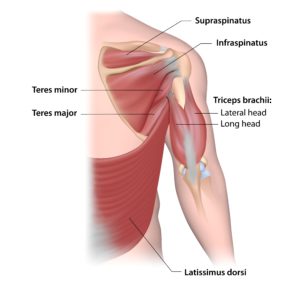
Do You Have a Rotator Cuff Tear?
Depending on your age, you might. Research indicates that rotator cuff tears are common and the likelihood of having a tear increases with age. Studies have shown the presence of such tears in more than 40% of individuals over the age of 60.
So what does this mean? Does every tear need to be surgically repaired or, at such a high prevalence, is this merely a sign of normal aging? First, it is important to determine whether or not such a tear is symptomatic or asymptomatic (i.e., does the presence of a tear cause pain and loss of function). The good news is that even in cases of symptomatic rotator cuff tears, surgery can usually be avoided with conservative management, including physical therapy.
The term “rotator cuff” refers to the four muscles that attach across the glenohumeral joint of the shoulder. This joint is comprised of a ball: the upper arm bone (humerus) and socket: the shoulder blade (glenoid/scapula). The muscles provide shoulder stability during arm movements. Injuries, including tears to the rotator cuff, can occur in an instant (acute) due to accident or trauma, or they can be the result of longer duration overuse (chronic).
Symptoms may include pain over the shoulder, which commonly extends into the upper arm. Patients may also experience weakness and loss of motion, including increased difficulty reaching overhead or behind back. Functional use of the arm also diminishes due to complaints of pain, weakness, and loss of motion. Not all shoulder related issues are due solely to tears of the rotator cuff. Injury can occur to other areas of the shoulder, either instead of or in combination with injury to the rotator cuff. In some instances, shoulder region pain may indicate referred pain from elsewhere in the body. So before assuming you have a rotator cuff tear, you should be evaluated by a healthcare professional.
If you have a symptomatic shoulder, a physical therapist specializing in orthopedics can evaluate your condition. Evaluation includes gaining an understanding of the patient’s history to determine contributing factors as well as a physical exam. In some instances, the results of this evaluation may indicate the need for referral to an orthopedist for advanced imaging (i.e., MRI), to determine injury severity and/or rule out other pathology. Typically the need for more advanced imaging is not advised as a first step.
Most commonly, physical therapy is advised as the first step, even in cases of a suspected rotator cuff tear. In many of these cases, a physical therapist is able to treat this condition effectively, with the goal of abolishing complaints of pain and restoring functional use of the arm/shoulder. Treatment includes specific shoulder strengthening and stretching exercises as well as manual intervention.
Physical therapy for the treatment of rotator cuff tears has been shown to be so effective that, in most cases, it is often the first and last step of treatment. The majority of patients, even those with confirmed rotator cuff tears, will not require surgical repair and are able to completely resolve related complaints of pain and functional loss through physical therapy alone.
If you have shoulder pain or symptoms, contact us today to be evaluated by one of our physical therapists!

